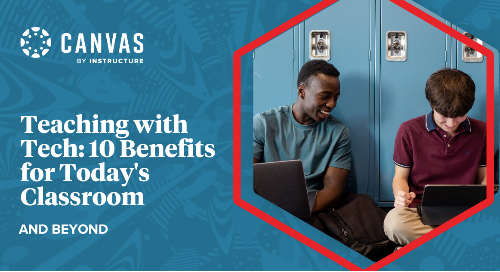
Classrooms that use technology reap many benefits. From accessibility to increased personalization and rich digital resources, teachers are learning how to best use technology to meet the needs of their diverse student population.
In Instructure’s State of Teaching & Learning in K-12 Education Research, 86% of teachers, parents, and educators believe using educational technology resources impacts students' success. Recently, classrooms have seen tremendous growth in technology use, which has come with growing pains, but the benefits of committing to long-term technology outweigh the risks.
“Now, more than ever, we recognize that digital tools are a great way to honor, respect, and provide equitable experiences for all students. It is a great way to give them what they need when they need it.”–Nancy Brightwell, Cheif Academic Officer at Charlotte-Mecklenburg Schools.
Let’s dig into some of the many benefits of using technology in the classroom today.
#1 Increase Student Engagement
Students are engaging with technology outside of school. Educators can embrace this reality and use technology to cultivate interactive and creative learning experiences for their students in the classroom. Video, for instance, can inspire and spark conversation in today’s students.
#2 Establish Consistency
A shared environment, like a learning management system, for every student, teacher, and guardian creates a place for connection and consistency. For most of history, this place has been the physical classroom. However, modern tools can recreate this familiarity in a digital environment.
“Canvas LMS can be the single landing place where you add all the digital curricula, content, and tools to support student learning, so students don't have to go to multiple places to find what they need.” –Trenton Goble, VP of K-12 Strategy at Instructure.
#3 Open Communication Lines
Administrators do not face the same challenges as their students, teachers, and families. For schools to operate smoothly, each of these parties needs to feel comfortable communicating about their challenges and confident they can reach out for support. Students know they can get help outside the physical classroom, and parents stay informed about their student’s learning (i.e., by using observer status to keep a pulse on what’s happening in the classroom). Administrators can offer support to teachers and families through the avenue that works best for their community, such as:
-
Office Hours
-
Phone & Email Support
-
Newsletters
-
Remind App
“Creating synchronous support made us [administrators] available to them [teachers and families]." Dr. Lisa Gilbert, Deputy Superintendent of Instruction at Kern County Schools
#4 Streamline Feedback
To grow, students need to hear feedback from their teachers; the sooner they receive it, the better. Teachers, on the other hand, have a lot on their plate. Technology features like SpeedGrader can help teachers quickly provide feedback when and where students need it most.
#5 Ease Student Anxiety
Technology can either amplify or alleviate anxiety. Answering the Fundamental Five, such as what students need to do when they need to do it and where they can reach out for support, helps educators accomplish the latter.
#6 Take Data-Informed Action
The right technology gives teachers the data they need when they need it most.
“For us, the focus is on real-time formative data. That is what is most meaningful. That is what we want to be able to work around. We can respond to needs more quickly than relying solely on end-of-the-year data. That is helpful, and we need to look at it, and we need to look for patterns and trends and address the issues we see there, but for us, it is more about real-time, what is happening now.” Nancy Brightwell, Chief Academic Officer at Charlotte-Mecklenburg Schools
A practical assessment management system is one way to access real-time information so educators can intervene efficiently.
#7 Boost College & Career Readiness
Technology is integral to our world. Connecting students with the right technology empowers them to take ownership of their learning in the present and prepares them for future success.
“We are thinking about our demographic and want to encourage as many students as possible to pursue post-secondary opportunities. It helps our teachers to embrace ‘the why’ when they learn that all our community colleges across our state are utilizing Canvas LMS.”–Dr. Lisa Gilbert, Deputy Superintendent of Instruction at Kern County Schools
#8 Enhance Collaboration
Classrooms without technology are bound to the time in the physical classroom for collaboration. Using technology makes students, teachers, and their families accessible beyond the confines of the building, whether through Zoom or Team meetings virtually or using Google Docs to work together on a project. Both foster collaboration and comments, version history, and activity in these tools inform teachers about who is contributing and who needs to engage.
#9 Reduce Paper Waste
Paper is still a valuable resource for schools. Estimates report that a typical school will use over 2,000 sheets of paper daily. Using digital resources and tech tools can save:
-
Educators' time at the printer
-
Students the stress of scouring folders for the correct sheet of paper to turn in
-
Schools the cost of ink, toner, and reams of paper
-
Excess paper from being thrown into the recycling bin
#10 Personalize Learning
Each student’s preferred learning path is unique. Technology provides opportunities to differentiate instruction and personalize learning by offering students multiple assignment submission types or a variety of mediums through which to learn new material. (i.e., Videos, podcasts, articles, etc.)
“Some things we have leveraged extensively are understanding how important digital content is and truly personalizing learning for students.”–Nancy Brightwell, Chief Academic Officer at Charlotte-Mecklenburg Schools.
How to Prepare Students for the Digital World
“We are graduating our students into a [digital] world. And these are the skillsets that we need to be helping them learn and apply…Do we not have a responsibility to ensure that our students are familiar with them? So that they can focus on the content they are learning, use the tools to dig deeper, collaborate online, and do all the wonderful things that Canvas LMS allows us to do.”–Dr. Lisa Gilbert, Deputy Superintendent of Instruction at Kern County Schools
To learn more about tackling the challenges associated with technology in the classroom, download your free copy of Removing Roadblocks to Teaching with Technology.
Related Content
 migracao-de-lms-article-2025-compressed.jpg
migracao-de-lms-article-2025-compressed.jpgArtigos
 modo_offline_do_aplicativo_canvas_para_alunos-pt.png
modo_offline_do_aplicativo_canvas_para_alunos-pt.pngArtigos

Artigos